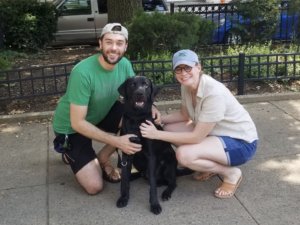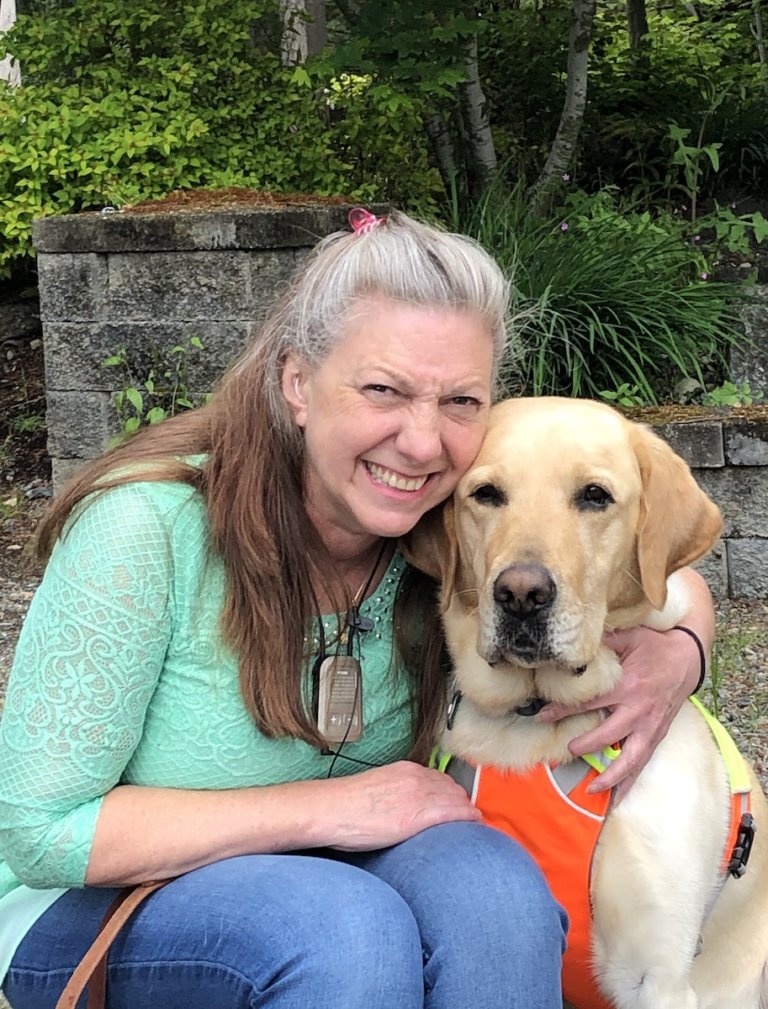Main Menu
| Puppy Raising | Beyond Puppy Program
There is great pride and responsibility in knowing the puppy you’re raising is on a path towards making a profound difference in someone’s life. Our puppy raisers are key to providing quality guide dogs.
Dogs are typically ready to start formal guide dog training when they are 14 to 18 months old. This can be a very emotional time for puppy raisers as they come to terms with the realization of parting. People often ask whether the first puppy is hardest to give up. It seems that each puppy assumes a special spot in your heart that holds the love, joy, and challenges you experienced together.
At the end of the puppy raising period, a decision is made as to whether the dog will proceed to guide dog training. This is determined after the review of previous temperament reports and the In-For-Training test, an indicator of training aptitude. The information derived from the IFT test is extremely important in determining the best career path for the dog. It also plays a crucial part in Guiding Eyes’ commitment to producing superb guide dogs.
During the IFT test the dog is exposed to various noises and objects and will also wear a guide dog harness and experience a mock vet exam in a controlled setting. The dog and handler will work both with and without food rewards, assessing the dog’s biddability, obedience, acceptance of body handling, and reaction to unusual stimuli. Confidence, patience, and a willingness to work as a team are some of the characteristics essential for guide dog work. Guiding Eyes believes each dog “chooses their own career.”

The date of a dog’s In-For-Training (IFT) is determined by their readiness, progress, and logistics involving other dogs needing to be scheduled and may be subject to change to meet the Training Department’s needs. Once the IFT is scheduled, raisers fill out a Final Evaluation form, providing information that will contribute to a smooth transition and optimal care for the dog.
When the dogs come in for training, our vets perform a thorough medical screening of each dog. Hip and elbows are evaluated for freedom from joint disease and eyes, heart, and other body systems are examined. Health problems or dietary restrictions that present potential maintenance issues or risk shortening the career of the guide dog, may be cause for release from guide dog training.
One of our most critical tasks is selecting the next generation of breeding dogs, which is why the puppies in our Puppy Raising Program generally remain reproductively intact until their IFT.
When evaluating a dog’s potential as a breeder, we consider their health history and temperament, as well as the health and temperament of their littermates. Approximately one-third of the dogs selected for breeding evaluation become Guiding Eyes breeders. There are multiple steps in the process, which typically takes several months to complete. For more information see Breeding & Genetics, and Brood Stud Program.
Upon completing their IFT and entering training, dogs are assigned to a Guide Dog Mobility Instructor who will develop a relationship with their dogs in training through a healthy balance of work and play. Dogs learn the concepts of guide work in small steps with each lesson building on previous lessons, and these skills are later proofed in a wide variety of environments and situations.
The instructors typically train a dog for three to four months to get them ready for placement with a person who is blind or visually impaired. For more information see Harness Training.
A guide dog is ready for placement when they respond reliably and safely to all work situations they will encounter while guiding such as indicating a curb or a change in elevation and navigating around obstacles. We carefully match each guide dog with a person based on pace, pull, personality and the person’s preferences. Raisers are notified of matches after the team begins training.
Guiding Eyes strives to put together a successful team where student and dog work effectively and comfortably with each other. For more information see Matching Process and Team Training.

Graduation ceremonies, whether virtual or in-person, celebrate newly matched guide dog teams and provide an opportunity for puppy raisers to connect with the partner of the dog they raised. Twice each month we celebrate our newest guide dog teams with our volunteer puppy raisers and other members of the Guiding Eyes Community. These celebrations are streamed live for anyone who is interested in attending virtually and recorded for viewing at another time. We invite you to share in these celebrations of partnership and new independence. Visit our Graduation page for more information.
This is an emotional time for both the raiser and the graduate. At an in-person event, raisers will be very excited about visiting the dog, but now there is another person involved in the dog’s life. Despite the time that’s passed since they’ve been together, the bond the dog and raiser share is strong. The graduate has had less time to develop a deep relationship with the dog, but in the future, they will work as the closest of partners. Raisers respect that relationship by asking for permission to visit, before speaking or interacting with the guide dog. Normally, the graduate will remove the harness in preparation for the greeting and retain control of the leash. Raisers do not take control of the leash unless it is offered, and if given control of the leash, do not leave the area of the graduate, but return the dog quickly, recognizing their future life together as a team.
Visit Guide Dogs 101 to learn more about guide dog etiquette.
Visit Graduation to learn more about this celebration of our new teams.
Guiding Eyes is mindful of a raiser’s desire to stay connected during the various phases of the pup’s career path.
Guiding Eyes for the Blind is approved by the Internal Revenue Service as a 501 (C) (3) tax-exempt organization, and all donations are tax deductible to the extent provided by law.
Guiding Eyes for the Blind Federal Identification Number (EIN) is 13-1854606.
© 2023 GUIDING EYES FOR THE BLIND PRIVACY POLICY | ACCESSIBILITY STATEMENT
| Cookie | Duration | Description |
|---|---|---|
| cookielawinfo-checkbox-analytics | 11 months | This cookie is set by GDPR Cookie Consent plugin. The cookie is used to store the user consent for the cookies in the category "Analytics". |
| cookielawinfo-checkbox-functional | 11 months | The cookie is set by GDPR cookie consent to record the user consent for the cookies in the category "Functional". |
| cookielawinfo-checkbox-necessary | 11 months | This cookie is set by GDPR Cookie Consent plugin. The cookies is used to store the user consent for the cookies in the category "Necessary". |
| cookielawinfo-checkbox-others | 11 months | This cookie is set by GDPR Cookie Consent plugin. The cookie is used to store the user consent for the cookies in the category "Other. |
| cookielawinfo-checkbox-performance | 11 months | This cookie is set by GDPR Cookie Consent plugin. The cookie is used to store the user consent for the cookies in the category "Performance". |
| viewed_cookie_policy | 11 months | The cookie is set by the GDPR Cookie Consent plugin and is used to store whether or not user has consented to the use of cookies. It does not store any personal data. |